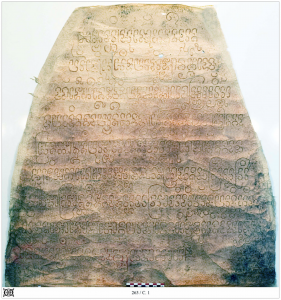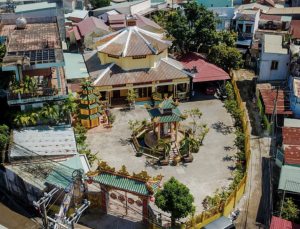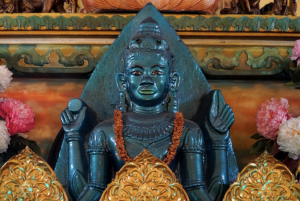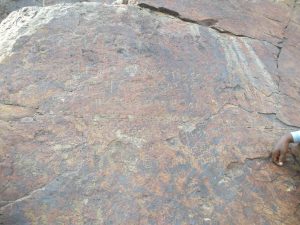Inscription on the Viṣṇu statue at Biên Hòa

Biên Hòa, Vietnam. Inscription on the reverse of the statue of Viṣṇu in the Bửu Sơn Pagoda (après © EFEO).
(1) |((quatrefoil))| svasti | pu pom̃ ku nan· sūnnu
(2) yām̃ pom̃ ku śrī jaya siṅhavarmmadeva
(3) urām̃ ṅauk· glauṅ· vijaya paripāla rāṣtra sim̃ tmum̃
(4) jaya di nagara yvan· ma°udyāṇna gulāc· tok· nagara
(5) braḥ kānda nī yuddha aneka sim̃ tmum̃ gulāc· jem̃ nagara ca-
(6) mpa di śaka loka aṣṭārdhanalaḥ ṇrapaḥ sakram̃tta tri-
(7) bhavanākrānta nī ṅan· ri jitta sa trā si sim̃ tmum̃ jaya di kvīra
(8) tmum̃ vuḥ bhogopabhoga yathādeva liṅga vukam̃n· rim̃ sim̃ jmai tmum̃
(9) jem̃ nagara kvīra jem̃ nagara campa sadākāla |
Notes: 3 urām̃ ◇ uraṅ Cabaton. — rāṣtra ◇ rāṣṭra Cabaton. — 6 aṣṭārdhanalaḥ ◇ ṣaṣṭārthānalaḥ Cabaton; aṣṭārdhānalaḥ Aymonier; aṣṭārdhanalaḥ Finot. The reading of Aymonier was included in an authorial addition to Cabaton 1904: 690, while Finot took the editorial liberty of inserting his own reading in n. 5 on that same page. Although we do not see a long ā-vocalization on the dg, we agree with Finot and Aymonier that it is necessary to understand aṣṭārdha-analaḥ. — ṇrapaḥ ◇ Finot; ṇdapaḥ Cabaton. The same spelling is found in C. 43, face B, l. 4 and 7. Finot’s reading is publised in n. 5 to . — sakram̃tta ◇ pakram̃ttha (?) Cabaton. Cf. C. 43, face A, l. 9 and c, l. 15 and 21; C. 118. — 6-7 tribhavanākrānta ◇ correct tribhuvanākrānta. The same correction is implicit from Cabaton’s translation. — 7 ra jitta ◇ vijitta Cabaton. — kvīra ◇ kvīr Cabaton. — 8 vukam̃n· ◇ vukān Cabaton. — 9 kvīra ◇ kvīr Cabaton.
INIG1338j Narwar Inscription of VS 1338j
INIG1338j phālguna śudi 11 Narwar (Shivpuri). On a slab in the shrine near Hawā paur. Number of lines not given, nāgarī, corrupt Sanskrit. Records the installation of Viṣṇu and the perpetual obeisance of Nāgo and Suhagā, the wives of Acitamaḍalīka.
INIG1150 Gowalior Fort Inscription of VS 1150
INIG1150 Gwalior fort (Gwalior). Two slabs in the porch of the Sās Bahū temple. 22 lines (right side) + 21 lines (left side), old nāgarī, Sanskrit. Describes the construction of and donations to Padmanātha (i.e. Viṣṇu) by the Kacchapaghāta ruler Mahīpāladeva. The main kings of the Kacchapaghāta dynasty are given in the inscription as: Lakṣmaṇa and his son Vajradāman (who defeated the king of Kannauj and conquered Gopādri); Maṅgalarāja; Kīrtirāja and his son Mūladeva (known as Bhuvanapāla and Trailokyamalla) who married Devavṛttā; his son Padmapāla; his heir Sūryapāla and his son Mahīpāla Bhuvanaikamalla who was a brother of Padmapāla. Composed by Maṇikaṇṭa, son of Govinda and the grandson of Rāma; written by Digambara Yaśodeva and inscribed by Padma Siṁhavāja and Māhula, sons of Devasvāmin.
INIG1098 Bara Inscription of VS 1098
INIG1098 Bārā (Shivpuri). Fragment of a large slab inscription. 8 lines, nāgarī, Sanskrit. Records the construction
of a temple of Viṣṇu (Garuḍāsana), a list of merchants involved in the work, and the name of the sūtradhāra Sthirārkka and poet Nārāyana. Now in Archaeological Museum, Gwalior.
INIG1082 Tongra Inscription of VS 1082
INIG1082 [bhadrapada ?] badi 5 Tongrā (Shivpuri).On an image of Nṛsiṃha. 17 lines, old nāgarī, Sanskrit. Describes the construction of a Viṣṇu temple; damaged. Now in the Archaeological Museum, Gwalior.
Viṣṇu statue at Biên Hòa with an old Cam inscription

Biên Hòa, Vietnam. Bửu Sơn Pagoda.

Biên Hòa, Vietnam. A statue of Viṣṇu in the Bửu Sơn Pagoda at Biên Hòa, carved in sandstone and inscribed on the reverse.
IN00111 Tosham rock inscription of Somatrata

Toshām, Haryana. Rock face with Vaiṣṇava inscription.
IN00100 Gwalior Stone Inscription of Mihirakula
Seven lines of text are extant. The first 2-3 characters of each line is lost. Much of the seventh line is also broken away along with lines 8 and 9, but these were extant and had been copied when the inscription was first noticed by scholars.